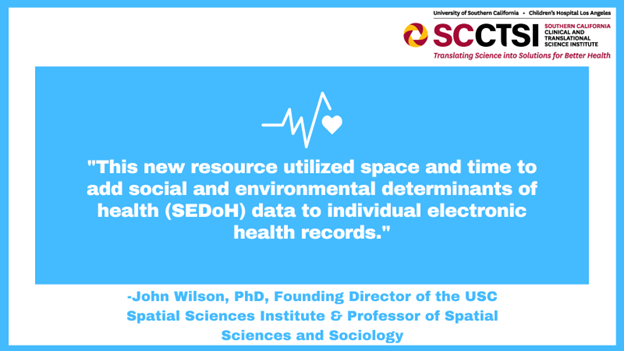SC CTSI researcher and colleagues create a toolkit to explore associations between disease and social and environmental factors
Novel uses of Geographic Information System (GIS) mapping programs can illuminate how multiple social and environmental determinants of health (SEDoH) drive disease and other health outcomes.
A research team at the Southern California Clinical and Translational Science Institute (SC CTSI), the University of Southern California and Children’s Hospital Los Angeles have developed a simple-to-use, open-source resource to enrich academic institutions’ clinical databases by incorporating SEDoH data and geographic information.

“This new resource utilized space and time to add SEDoH data to individual electronic health records and means the most appropriate SEDoH data are linked to selected parts of the electronic health records of individual patients,” said John Wilson, Professor of Architecture, Civil & Environmental Engineering, Computer Science, Population and Public Health Sciences and Sociology, and the Founding Director of the USC Spatial Sciences Institute.
This new Social and Environmental Determinants Address Enhancement (SEnDAE) (pronounced “sundae”) toolkit is introduced in the journal Computer Methods and Programs in Biomedicine.
[Use the link at the bottom of this article to access the toolkit]
The new program includes 42 curated, geocoded social and environmental variables from national and California governmental datasets. Academic investigators can search the toolkit for geographic matches between clinical health records and the 42 variables, while also protecting patient privacy.
“The toolkit allows you to identify patients with a specific ailment—such as asthma—and link them to geocoded addresses and environmental exposure data such as air quality or housing or other determinant data,” said Neil Bahroos, MS, MBA, Associate Professor of Research Population and Public Health Sciences and Chief Research Informatics Officer at the Keck School of Medicine, University of Southern California.
Bahroos is also the Director of the Clinical Research Informatics core at SC CTSI, which provides expertise in data integration, data sharing and data security to help drive the integration of clinical care and clinical research.
Clinicians can often learn directly from patients about potential social determinants of health, such as insecure employment or overcrowded housing. But patients are unlikely to know local environmental conditions such as air quality data.
Local, state and national government organizations collect environmental data, and many release them at no cost to researchers. But environmental-exposure databases, managed by government agencies, were not designed for use by population health researchers.
The new toolkit automates many complex data management and analytical tasks. Population researchers can create map visualizations that could reveal connections between multiple SEDoH variables and health outcomes. The toolkit can be used to identify areas with high rates of chronic diseases, such as diabetes or heart disease, and determine factors contributing to those rates without exposing personal health information in the form of patient addresses.
“We prepared, organized and curated these data for accuracy, so researchers can efficiently connect the dots between the patients’ neighborhoods and social and environmental exposure data associated with those neighborhoods,” said Bahroos. “You can mix variables such as education, ethnicity, housing, preferred language and look for matches with diagnoses or surgical procedures.”
The SEnDAE toolkit is designed to aid institutions lacking programming resources or expertise. The program guides institutions on how to integrate environmental variables with data warehouses and medical cohort discovery tools like Informatics for Integrating Biology & the Bedside (i2b2). This would enable researchers to search for cohorts using criteria based on SEDoH variables.
The program could fill crucial gaps in precision healthcare. Clinical systems could potentially employ the advanced GIS toolkit to match an individual patient’s diagnosis with SEDoH data to visualize multiple potential determinants of that particular health condition and offer more targeted treatments and help positively affect health outcomes.
Interesting in accessing the GIS toolkit? Go HERE.



